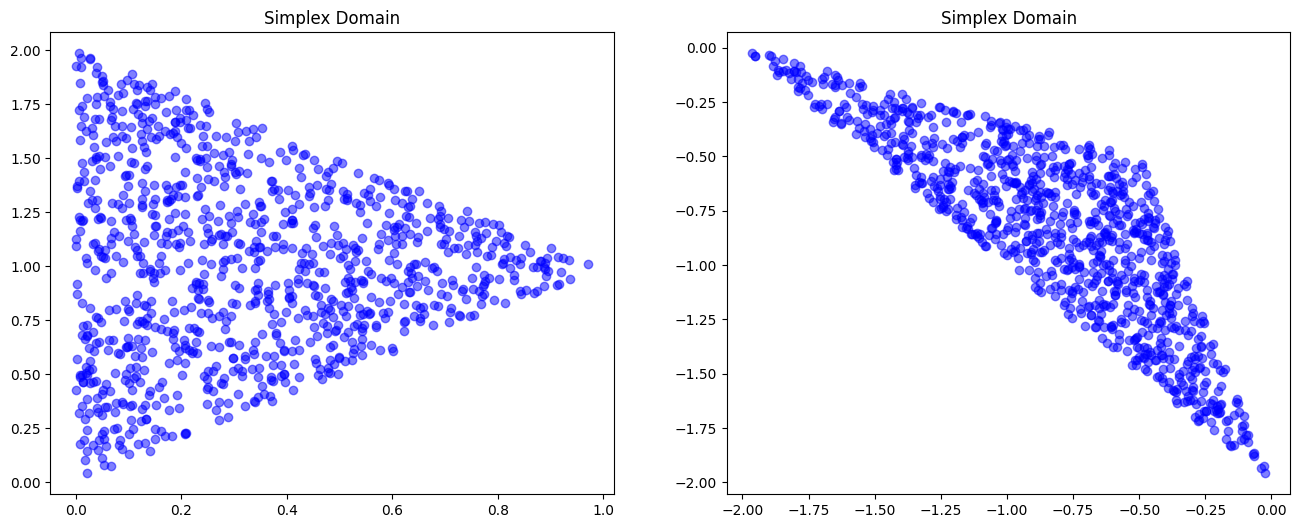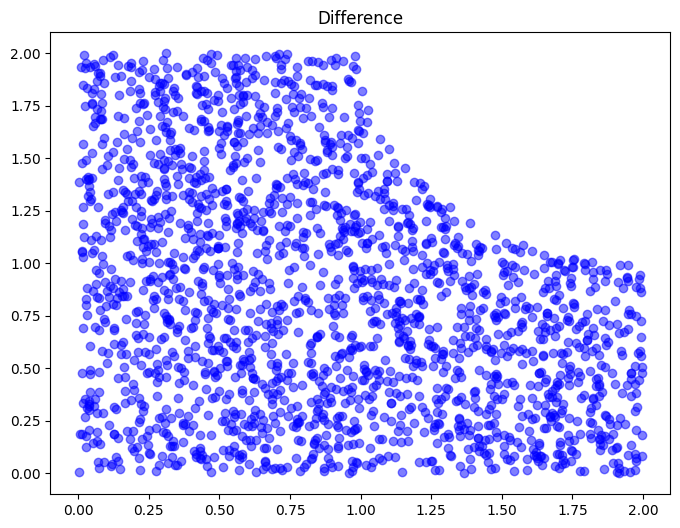Tutorial: Building custom geometries with PINA Location class#
In this tutorial we will show how to use geometries in PINA. Specifically, the tutorial will include how to create geometries and how to visualize them. The topics covered are:
Creating CartesianDomains and EllipsoidDomains
Getting the Union and Difference of Geometries
Sampling points in the domain (and visualize them)
We import the relevant modules first.
## routine needed to run the notebook on Google Colab
try:
import google.colab
IN_COLAB = True
except:
IN_COLAB = False
if IN_COLAB:
!pip install "pina-mathlab"
import matplotlib.pyplot as plt
plt.style.use('tableau-colorblind10')
from pina.geometry import EllipsoidDomain, Difference, CartesianDomain, Union, SimplexDomain
from pina.label_tensor import LabelTensor
def plot_scatter(ax, pts, title):
ax.title.set_text(title)
ax.scatter(pts.extract('x'), pts.extract('y'), color='blue', alpha=0.5)
Built-in Geometries#
We will create one cartesian and two ellipsoids. For the sake of simplicity, we show here the 2-dimensional, but it’s trivial the extension to 3D (and higher) cases. The geometries allows also the generation of samples belonging to the boundary. So, we will create one ellipsoid with the border and one without.
cartesian = CartesianDomain({'x': [0, 2], 'y': [0, 2]})
ellipsoid_no_border = EllipsoidDomain({'x': [1, 3], 'y': [1, 3]})
ellipsoid_border = EllipsoidDomain({'x': [2, 4], 'y': [2, 4]}, sample_surface=True)
The {'x': [0, 2], 'y': [0, 2]} are the bounds of the
CartesianDomain being created.
To visualize these shapes, we need to sample points on them. We will use
the sample method of the CartesianDomain and EllipsoidDomain
classes. This method takes a n argument which is the number of
points to sample. It also takes different modes to sample such as
random.
cartesian_samples = cartesian.sample(n=1000, mode='random')
ellipsoid_no_border_samples = ellipsoid_no_border.sample(n=1000, mode='random')
ellipsoid_border_samples = ellipsoid_border.sample(n=1000, mode='random')
We can see the samples of each of the geometries to see what we are working with.
print(f"Cartesian Samples: {cartesian_samples}")
print(f"Ellipsoid No Border Samples: {ellipsoid_no_border_samples}")
print(f"Ellipsoid Border Samples: {ellipsoid_border_samples}")
Cartesian Samples: labels(['x', 'y'])
LabelTensor([[[0.2300, 1.6698]],
[[1.7785, 0.4063]],
[[1.5143, 1.8979]],
...,
[[0.0905, 1.4660]],
[[0.8176, 1.7357]],
[[0.0475, 0.0170]]])
Ellipsoid No Border Samples: labels(['x', 'y'])
LabelTensor([[[1.9341, 2.0182]],
[[1.5503, 1.8426]],
[[2.0392, 1.7597]],
...,
[[1.8976, 2.2859]],
[[1.8015, 2.0012]],
[[2.2713, 2.2355]]])
Ellipsoid Border Samples: labels(['x', 'y'])
LabelTensor([[[3.3413, 3.9400]],
[[3.9573, 2.7108]],
[[3.8341, 2.4484]],
...,
[[2.7251, 2.0385]],
[[3.8654, 2.4990]],
[[3.2292, 3.9734]]])
Notice how these are all LabelTensor objects. You can read more
about these in the
documentation.
At a very high level, they are tensors where each element in a tensor
has a label that we can access by doing <tensor_name>.labels. We can
also access the values of the tensor by doing
<tensor_name>.extract(['x']).
We are now ready to visualize the samples using matplotlib.
fig, axs = plt.subplots(1, 3, figsize=(16, 4))
pts_list = [cartesian_samples, ellipsoid_no_border_samples, ellipsoid_border_samples]
title_list = ['Cartesian Domain', 'Ellipsoid Domain', 'Ellipsoid Border Domain']
for ax, pts, title in zip(axs, pts_list, title_list):
plot_scatter(ax, pts, title)

We have now created, sampled, and visualized our first geometries! We
can see that the EllipsoidDomain with the border has a border around
it. We can also see that the EllipsoidDomain without the border is
just the ellipse. We can also see that the CartesianDomain is just a
square.
Simplex Domain#
Among the built-in shapes, we quickly show here the usage of
SimplexDomain, which can be used for polygonal domains!
import torch
spatial_domain = SimplexDomain(
[
LabelTensor(torch.tensor([[0, 0]]), labels=["x", "y"]),
LabelTensor(torch.tensor([[1, 1]]), labels=["x", "y"]),
LabelTensor(torch.tensor([[0, 2]]), labels=["x", "y"]),
]
)
spatial_domain2 = SimplexDomain(
[
LabelTensor(torch.tensor([[ 0., -2.]]), labels=["x", "y"]),
LabelTensor(torch.tensor([[-.5, -.5]]), labels=["x", "y"]),
LabelTensor(torch.tensor([[-2., 0.]]), labels=["x", "y"]),
]
)
pts = spatial_domain2.sample(100)
fig, axs = plt.subplots(1, 2, figsize=(16, 6))
for domain, ax in zip([spatial_domain, spatial_domain2], axs):
pts = domain.sample(1000)
plot_scatter(ax, pts, 'Simplex Domain')

Boolean Operations#
To create complex shapes we can use the boolean operations, for example
to merge two default geometries. We need to simply use the Union
class: it takes a list of geometries and returns the union of them.
Let’s create three unions. Firstly, it will be a union of cartesian
and ellipsoid_no_border. Next, it will be a union of
ellipse_no_border and ellipse_border. Lastly, it will be a union
of all three geometries.
cart_ellipse_nb_union = Union([cartesian, ellipsoid_no_border])
cart_ellipse_b_union = Union([cartesian, ellipsoid_border])
three_domain_union = Union([cartesian, ellipsoid_no_border, ellipsoid_border])
We can of course sample points over the new geometries, by using the
sample method as before. We highlihgt that the available sample
strategy here is only random.
c_e_nb_u_points = cart_ellipse_nb_union.sample(n=2000, mode='random')
c_e_b_u_points = cart_ellipse_b_union.sample(n=2000, mode='random')
three_domain_union_points = three_domain_union.sample(n=3000, mode='random')
We can plot the samples of each of the unions to see what we are working with.
fig, axs = plt.subplots(1, 3, figsize=(16, 4))
pts_list = [c_e_nb_u_points, c_e_b_u_points, three_domain_union_points]
title_list = ['Cartesian with Ellipsoid No Border Union', 'Cartesian with Ellipsoid Border Union', 'Three Domain Union']
for ax, pts, title in zip(axs, pts_list, title_list):
plot_scatter(ax, pts, title)

Now, we will find the differences of the geometries. We will find the
difference of cartesian and ellipsoid_no_border.
cart_ellipse_nb_difference = Difference([cartesian, ellipsoid_no_border])
c_e_nb_d_points = cart_ellipse_nb_difference.sample(n=2000, mode='random')
fig, ax = plt.subplots(1, 1, figsize=(8, 6))
plot_scatter(ax, c_e_nb_d_points, 'Difference')

Create Custom Location#
We will take a look on how to create our own geometry. The one we will try to make is a heart defined by the function
Let’s start by importing what we will need to create our own geometry based on this equation.
import torch
from pina import Location
from pina import LabelTensor
import random
Next, we will create the Heart(Location) class and initialize it.
class Heart(Location):
"""Implementation of the Heart Domain."""
def __init__(self, sample_border=False):
super().__init__()
Because the Location class we are inherting from requires both a
sample method and is_inside method, we will create them and just
add in “pass” for the moment.
class Heart(Location):
"""Implementation of the Heart Domain."""
def __init__(self, sample_border=False):
super().__init__()
def is_inside(self):
pass
def sample(self):
pass
Now we have the skeleton for our Heart class. The sample
method is where most of the work is done so let’s fill it out.
class Heart(Location):
"""Implementation of the Heart Domain."""
def __init__(self, sample_border=False):
super().__init__()
def is_inside(self):
pass
def sample(self, n, mode='random', variables='all'):
sampled_points = []
while len(sampled_points) < n:
x = torch.rand(1)*3.-1.5
y = torch.rand(1)*3.-1.5
if ((x**2 + y**2 - 1)**3 - (x**2)*(y**3)) <= 0:
sampled_points.append([x.item(), y.item()])
return LabelTensor(torch.tensor(sampled_points), labels=['x','y'])
To create the Heart geometry we simply run:
heart = Heart()
To sample from the Heart geometry we simply run:
pts_heart = heart.sample(1500)
fig, ax = plt.subplots()
plot_scatter(ax, pts_heart, 'Heart Domain')

What’s next?#
We have made a very simple tutorial on how to build custom geometries and use domain operation to compose base geometries. Now you can play around with different geometries and build your own!
